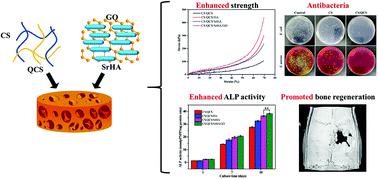当前位置:
X-MOL 学术
›
Biomater. Sci.
›
论文详情
Our official English website, www.x-mol.net, welcomes your
feedback! (Note: you will need to create a separate account there.)
Strontium-substituted hydroxyapatite grown on graphene oxide nanosheet-reinforced chitosan scaffold to promote bone regeneration.
Biomaterials Science ( IF 5.8 ) Pub Date : 2020-06-19 , DOI: 10.1039/d0bm00523a Tingting Wu 1 , Binglin Li , Wanshun Wang , Lingling Chen , Zhan Li , Ming Wang , Zhengang Zha , Zefeng Lin , Hong Xia , Tao Zhang
Biomaterials Science ( IF 5.8 ) Pub Date : 2020-06-19 , DOI: 10.1039/d0bm00523a Tingting Wu 1 , Binglin Li , Wanshun Wang , Lingling Chen , Zhan Li , Ming Wang , Zhengang Zha , Zefeng Lin , Hong Xia , Tao Zhang
Affiliation

|
The strontium-substituted hydroxyapatite (SrHA) is a commonly used material in bone regeneration for its good osteoconductivity and high alkaline phosphatase (ALP) activity. Scaffolds used in bone defects require a high compressive modulus. However, the SrHA nanoparticle-doped scaffold cannot properly fit the required mechanical properties. Therefore, a lot of effort has been used to fabricate synthetic bone scaffolds with biocompatibility, suitable mechanical properties, antibacterial ability and osteoconductivity. Here, we used a facile hydrothermal method to synthesize graphene oxide (GO)-reinforced SrHA nanoparticles. The incorporation of GO can be used as nucleation and growth active sites of hydroxyapatite. In addition, GO is easy to self-assemble into a layered structure in the dispersion, which can effectively regulate the deposition of hydroxyapatite on the surface of GO. The scaffold was fabricated using a freeze-drying method by incorporating SrHA/GO nanoparticles into chitosan (CS) and quaternized chitosan (QCS) mixed solutions. The compressive modulus of the CS/QCS/SrHA/GO scaffold reached 438.5 kPa, which was 4-fold higher than that of the CS/QCS scaffold. The CS/QCS/SrHA/GO scaffold exhibited significantly higher in vitro mineralization levels and ALP activity. In vivo rat skull repair indicated that the CS/QCS/SrHA/GO scaffold had a significant role in promoting bone regeneration. This study provides a new strategy for modifying hydroxyapatite to satisfy the biomedical demand of bone tissue engineering scaffolds.
中文翻译:

在氧化石墨烯纳米片增强的壳聚糖支架上生长的锶取代羟基磷灰石可促进骨骼再生。
锶取代的羟基磷灰石(SrHA)是具有良好的骨传导性和高碱性磷酸酶(ALP)活性的骨再生中常用的材料。用于骨缺损的支架需要高压缩模量。但是,SrHA纳米粒子掺杂的支架不能适当地满足所需的机械性能。因此,已经花费了很多努力来制造具有生物相容性,合适的机械性能,抗菌能力和骨传导性的合成骨支架。在这里,我们使用一种简便的水热方法来合成氧化石墨烯(GO)增强SrHA纳米粒子。GO的掺入可用作羟基磷灰石的成核和生长活性位点。此外,GO易于在分散体中自组装成分层结构,可以有效地调节羟基磷灰石在GO表面的沉积。通过将SrHA / GO纳米粒子掺入壳聚糖(CS)和季铵化壳聚糖(QCS)混合溶液中,使用冷冻干燥方法制造支架。CS / QCS / SrHA / GO支架的压缩模量达到438.5 kPa,比CS / QCS支架高4倍。CS / QCS / SrHA / GO支架表现出明显更高的水平体外矿化水平和ALP活性。体内大鼠颅骨修复表明CS / QCS / SrHA / GO支架在促进骨再生中具有重要作用。这项研究为改性羟基磷灰石提供了一种新的策略,以满足骨组织工程支架的生物医学需求。
更新日期:2020-08-11
中文翻译:

在氧化石墨烯纳米片增强的壳聚糖支架上生长的锶取代羟基磷灰石可促进骨骼再生。
锶取代的羟基磷灰石(SrHA)是具有良好的骨传导性和高碱性磷酸酶(ALP)活性的骨再生中常用的材料。用于骨缺损的支架需要高压缩模量。但是,SrHA纳米粒子掺杂的支架不能适当地满足所需的机械性能。因此,已经花费了很多努力来制造具有生物相容性,合适的机械性能,抗菌能力和骨传导性的合成骨支架。在这里,我们使用一种简便的水热方法来合成氧化石墨烯(GO)增强SrHA纳米粒子。GO的掺入可用作羟基磷灰石的成核和生长活性位点。此外,GO易于在分散体中自组装成分层结构,可以有效地调节羟基磷灰石在GO表面的沉积。通过将SrHA / GO纳米粒子掺入壳聚糖(CS)和季铵化壳聚糖(QCS)混合溶液中,使用冷冻干燥方法制造支架。CS / QCS / SrHA / GO支架的压缩模量达到438.5 kPa,比CS / QCS支架高4倍。CS / QCS / SrHA / GO支架表现出明显更高的水平体外矿化水平和ALP活性。体内大鼠颅骨修复表明CS / QCS / SrHA / GO支架在促进骨再生中具有重要作用。这项研究为改性羟基磷灰石提供了一种新的策略,以满足骨组织工程支架的生物医学需求。











































 京公网安备 11010802027423号
京公网安备 11010802027423号